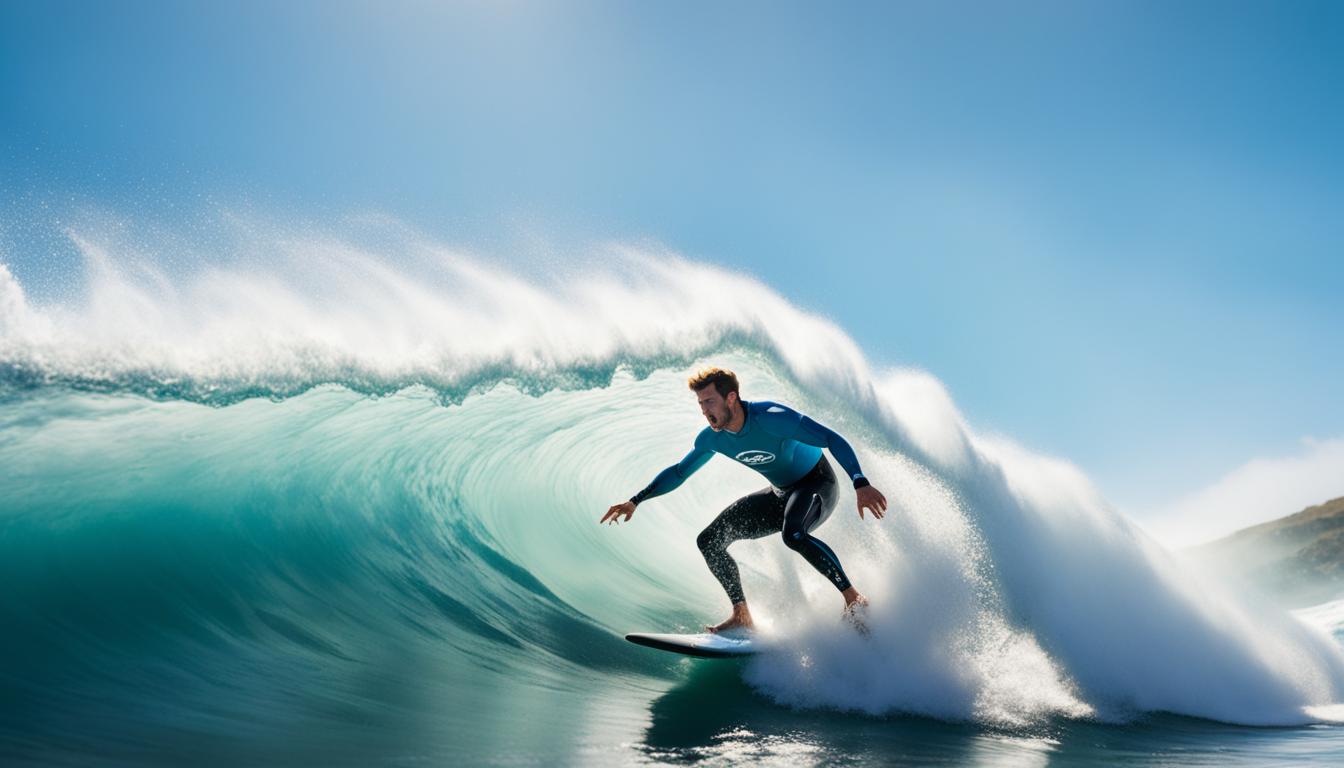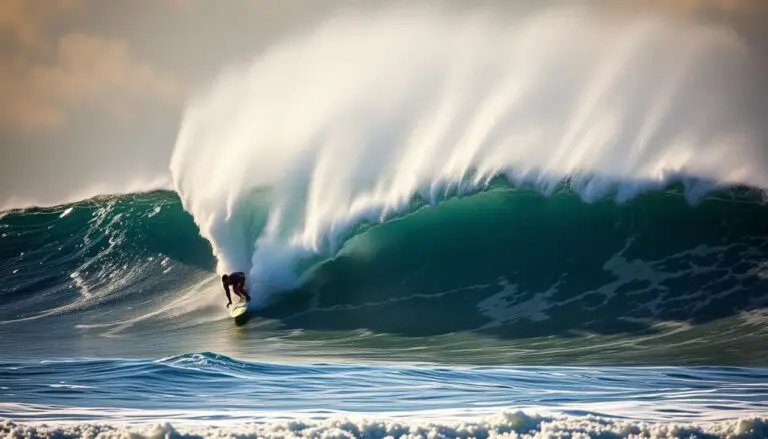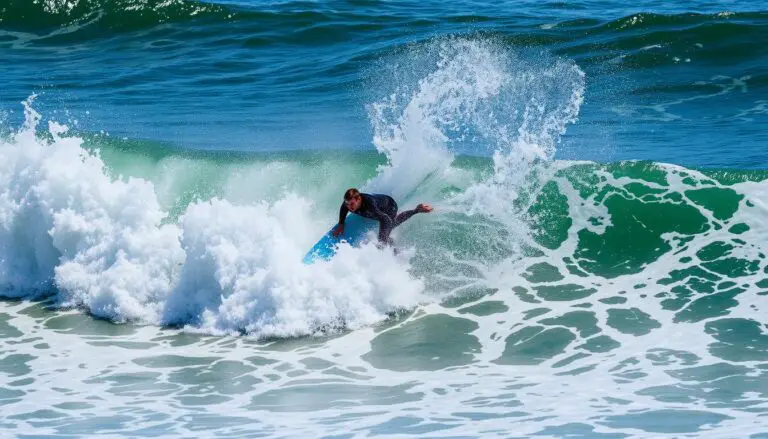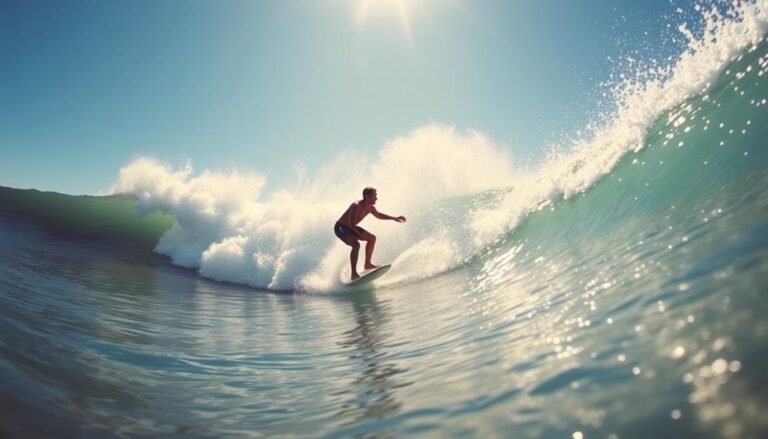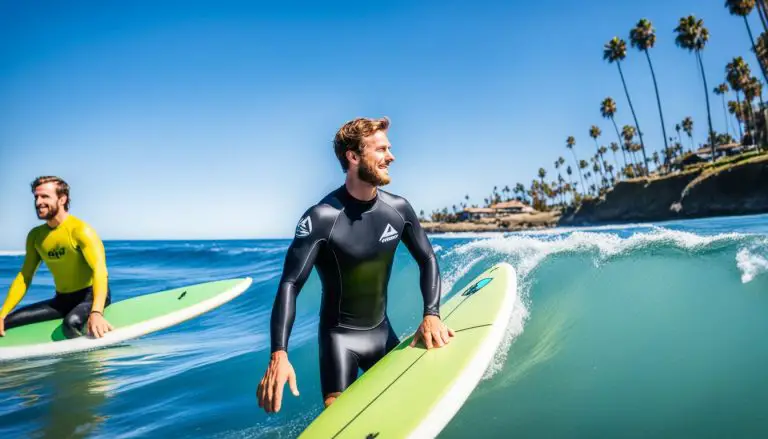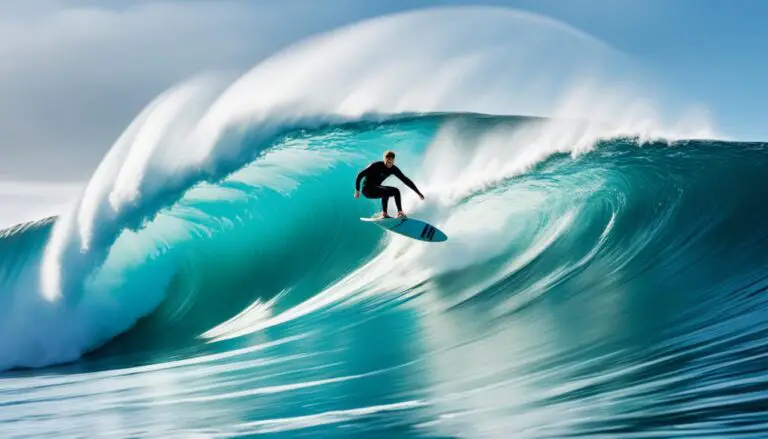Speed Generation in Surfing: How to Go Faster on Waves
Learning how to generate speed while surfing is key to unlocking the full potential of your wave-riding experience. Whether you’re a beginner looking to improve your surf speed or an experienced surfer aiming to take it to the next level, understanding the techniques to go faster on waves is essential.
In this article, we’ll dive deep into the world of speed generation in surfing and provide you with valuable tips and tricks to enhance your performance. From mastering the basics of positioning and using gravity to your advantage to utilizing rail engagement and pumping techniques, we’ll cover it all.
So, if you’re ready to ride the waves at exhilarating speeds and experience the thrill of effortlessly gliding across the water, join us as we explore the secrets to surf speed success. Let’s get started on your journey to becoming a faster, more dynamic surfer!
Understanding Speed Generation Basics
To effectively generate speed in surfing, it is important to grasp the fundamentals. Factors such as your surfing equipment, wave positioning, and surfing stance all play a crucial role in speed generation. Understanding how your surfboard’s rocker, volume, and dimensions impact your acceleration, as well as knowing how to position yourself on the wave and maintain a proper surfing stance, are essential components of speed generation. These basics will lay the foundation for more advanced techniques.
Surfing Equipment
Your choice of surfing equipment greatly affects your ability to generate speed on the waves. The rocker, or the curve along the bottom of your surfboard, determines how well the board glides through the water and generates speed. A more pronounced rocker can help you maneuver on steeper waves, while a flatter rocker provides greater speed on smaller, flatter waves. Additionally, the volume and dimensions of your surfboard influence its buoyancy and maneuverability, both of which contribute to speed generation.
Wave Positioning
Proper wave positioning is key to maximizing your speed potential. Positioning yourself in the right spot on the wave allows you to catch it at its critical or steepest point, where you can harness the energy and acceleration it provides. By understanding how waves break and reading the ocean conditions, you can anticipate where the best opportunities for speed generation lie. Additionally, being able to identify the peel or the direction the wave is breaking can help you position yourself more effectively.
Surfing Stance
Your surfing stance can significantly impact your ability to generate speed on the wave. Maintaining a balanced and functional stance allows you to transfer your weight efficiently, making it easier to engage the rails of your surfboard and generate momentum. Distribute your weight evenly between your front and back foot, with your knees slightly bent and your body centered over the board. This stance helps optimize your control and maneuverability, enabling you to generate speed with ease.
Positioning for Speed at Take Off
Your positioning at take off is crucial for setting yourself up for speed generation. By aiming to take off at the peak, the steepest part of the wave, you can utilize gravity and gain momentum as you drop down towards the shoulder.
Positioning yourself correctly enables you to generate speed by using the wave’s gravitational energy to your advantage. Understanding how to read the wave and position yourself accordingly is essential for maximizing your speed potential.
When you position yourself at the peak of the wave, you accelerate more efficiently as you descend towards the shoulder, taking advantage of the wave’s natural energy. This acceleration propels you forward and allows for enhanced surf performance.
How to Properly Position Yourself for Speed Generation:
- Read the Wave: Observe the shape and behavior of the wave to identify the steepest part, or peak. This is where you want to take off.
- Paddle with Purpose: Paddle towards the peak with strong and deliberate strokes, aiming to arrive just as the wave is breaking at its steepest point.
- Timing is Key: Time your pop-up so that you catch the wave right at its peak, ensuring maximum speed potential.
- Stay Balanced: Maintain a stable and centered stance on your surfboard as you drop down towards the shoulder, ready to take advantage of the wave’s energy.
“Positioning yourself correctly at take off is like launching yourself into a wave-riding rocket. By recognizing the steepest part of the wave and aligning yourself with it, you’ll experience an exhilarating acceleration that propels you forward at incredible speeds.” – Pro Surfer Kelly Slater
Positioning for speed at take off is a fundamental skill that can significantly enhance your surf performance. By harnessing the power of gravity and positioning yourself at the peak of the wave, you can tap into the wave’s energy and generate impressive speed. Practice reading and understanding waves, time your take offs, and maintain balance throughout the ride to maximize your speed potential and take your surfing to new heights.
| Benefits of Proper Positioning at Take Off | How it Helps |
|---|---|
| Accelerating on Waves | Positioning yourself at the peak allows you to utilize gravity and gain momentum, resulting in accelerated speeds on the wave. |
| Enhanced Surf Performance | By generating speed from the beginning, you can perform maneuvers more dynamically and with greater precision, enhancing your overall surf performance. |
| Wave Speed Generation | Proper positioning at take off sets you up for wave speed generation throughout the ride, allowing for continuous momentum and an exhilarating surf experience. |
Utilizing Gravity and Rail Engagement
Surfers can achieve impressive speed by effectively utilizing gravity and engaging the rails of their surfboard. When taking off on the steeper parts of the wave, surfers convert potential gravitational energy into motion energy, allowing them to gain speed during the initial drop. This acceleration is crucial for maximizing speed generation. As surfers ride from the top to the bottom of the wave face, they can harness the wave’s energy to gain momentum. Each time they go back up and down, their speed increases, propelling them forward.
Moreover, the strategic use of the surfboard’s rails can further enhance speed generation. By employing rail engagement techniques, surfers can redirect the water underneath their board. This redirection increases lift and reduces drag, resulting in improved speed. Carving at the bottom of the wave involves making smooth, powerful turns by angling the surfboard’s rails into the wave face. This technique allows surfers to accelerate while maintaining control and stability.
By effectively combining the principles of gravity utilization and rail engagement, surfers can unlock the full potential of their speed generation capabilities.
Benefits of Utilizing Gravity and Rail Engagement:
- Increased speed during the initial drop on steeper waves
- Improved speed generation with each ride up and down the wave face
- Enhanced lift and reduced drag through rail engagement techniques
- Greater control and stability while maintaining accelerated speed
Mastering these surfing speed hacks can take your surfing to the next level, allowing you to fully enjoy the exhilarating thrill of riding waves at high speeds.
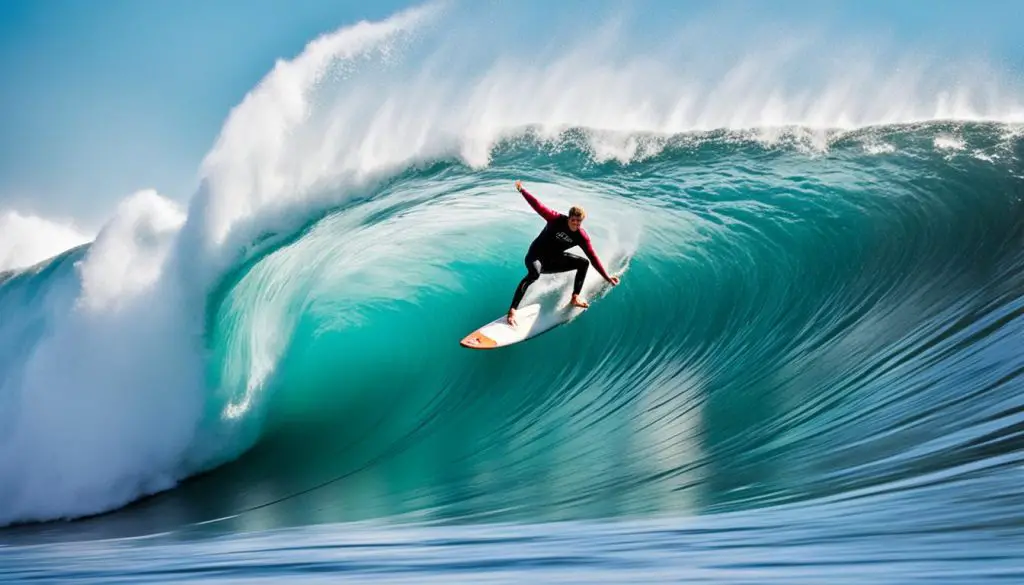
Mastering Pumping and Bouncing Techniques
When it comes to generating speed on the wave, two effective techniques to master are pumping and bouncing. These techniques require skill and practice but can significantly enhance your ability to surf faster and maintain momentum.
Pumping: Pumping involves a smooth, flowing motion of moving up and down the face of the wave. To execute this technique, use your back foot to apply pressure and your front foot to maintain balance. By leveraging the wave’s energy and your body’s movement, you can maintain speed and generate momentum. As you pump, focus on coordinating your movements with the wave’s natural rhythm, allowing it to propel you forward.
Bouncing: Bouncing is a technique that combines both up and down and side to side movements. It involves shifting your weight between the back foot and the front foot, propelling your surfboard forward on the wave. As you shift your weight from one foot to the other, you generate additional speed by harnessing the wave’s energy. This dynamic movement enables you to surf faster and maneuver with agility.
Both pumping and bouncing techniques require a deep understanding of wave dynamics and precise footwork. Practice these techniques in a controlled environment to enhance your speed generation skills. With time and dedication, you can become proficient in these techniques and elevate your surfing performance to new heights.
Benefits of Pumping and Bouncing Techniques
Mastering pumping and bouncing techniques offers several benefits for surfers seeking to maximize their speed on the wave:
- Increased Speed: By implementing these techniques, you can generate and maintain higher speeds, allowing you to take advantage of the wave’s energy and perform more dynamic maneuvers.
- Improved Maneuverability: Pumping and bouncing enable you to maneuver and change direction quickly, giving you greater control over your surfboard and allowing for more precise turns and transitions.
- Enhanced Fluidity: These techniques add a fluid and rhythmic element to your surfing, creating a seamless connection between yourself and the wave.
- Maximized Wave Potential: By effectively generating speed, you can unlock the full potential of each wave, allowing for longer rides and more thrilling surfing experiences.
Whether you’re a beginner or an experienced surfer, incorporating pumping and bouncing techniques into your repertoire will undoubtedly enhance your speed generation abilities. Experiment, refine, and adapt these techniques to suit your individual style and the unique conditions of each wave you encounter.
Expert Tip:
“Focus on reading the wave and adjusting your footwork accordingly. Utilize the wave’s energy, engage your core, and let the natural rhythm guide your movements. With practice, pumping and bouncing will become second nature, enabling you to surf faster and with more fluidity.”
By mastering pumping and bouncing techniques, along with other speed generation principles, you’ll be well on your way to becoming a faster and more dynamic surfer. Practice regularly, stay focused, and continue to explore new ways to enhance your speed on the waves.
| Benefits of Pumping and Bouncing Techniques |
|---|
| Increased Speed |
| Improved Maneuverability |
| Enhanced Fluidity |
| Maximized Wave Potential |
Conclusion
Mastering the art of speed generation is essential for surf performance enhancement and increased wave speed. By incorporating the fundamental techniques of positioning, gravity utilization, rail engagement, and pumping and bouncing, surfers can elevate their performance to new heights. Remember to always prioritize safety when attempting these maneuvers and continue practicing to refine your skills.
Understanding the basics of speed generation, such as taking off at the peak of the wave and using gravity to gain momentum, sets the foundation for success. Engaging the rails of your surfboard and carving at the bottom of the wave further enhances speed and maneuverability. Additionally, mastering techniques like pumping and bouncing allows for continuous speed generation on the wave.
By constantly honing your skills and gaining experience, you will become an expert at generating speed and maximizing your potential on the waves. So get out there, stay safe, and enjoy the exhilarating sensation of riding the waves with enhanced speed and performance.

